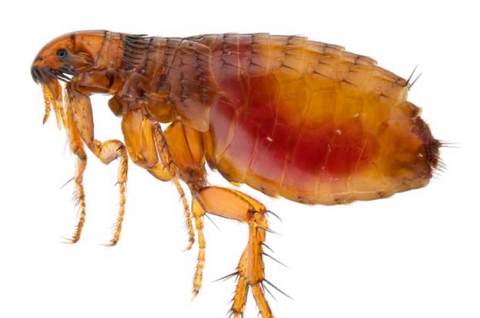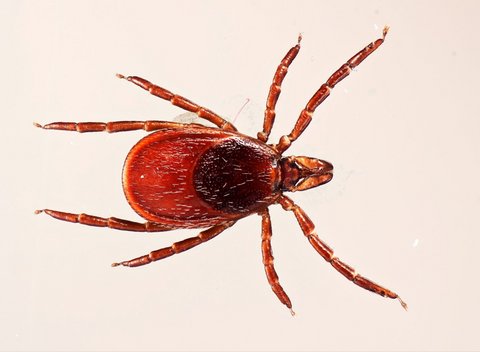How to Make Your House Flea and Tick Free Inside and Outside

When it comes to creating a safe and comfortable environment for your family and pets, one aspect that often gets overlooked is keeping your home and yard free from fleas and ticks.
These tiny, blood-sucking pests not only cause irritation and discomfort but also pose significant health risks to both humans and animals.
Fleas and ticks are notorious for transmitting diseases and can turn a peaceful home and outdoor space into a source of endless itching and worry.
Identifying Fleas and Ticks
Fleas and ticks may be small, but their impact can be disproportionately significant. Let's take a closer look at these troublesome creatures and provide some valuable insights to help you recognize them:
Fleas (Ctenocephalides spp.):
Appearance - Fleas are tiny, dark brown to reddish-brown insects, measuring just 1-2 millimeters in length. They have a flattened, wingless body covered in spines, and their long, powerful hind legs are designed for jumping, enabling them to leap remarkable distances.
Characteristics - These agile pests are known for their relentless biting and rapidly reproducing. A single female flea can lay up to 50 eggs per day, making infestations spread like wildfire. Flea bites often appear as small, itchy red bumps, and they can be particularly bothersome for both humans and pets.
Behavior - Fleas are agile jumpers, capable of leaping around 150 times their own body length. This agility allows them to move swiftly between hosts, whether it's your pet or even you. They feed on the blood of their host, causing itching and discomfort.
Lifecycle - Fleas undergo four distinct life stages: egg, larva, pupa, and adult. Eggs are laid on the host but often fall off into the environment. Larvae feed on organic debris, pupate in silken cocoons, and emerge as adults when stimulated by host movement or warmth.
Habits - Fleas tend to infest areas where your pets spend a lot of time. This includes your pet's bedding, carpets, and upholstered furniture. They can also hide in cracks and crevices in flooring, waiting for the next host to pass by.

Ticks (Ixodida):
Appearance - Ticks come in various sizes and colors depending on the species, but they generally have a round or oval-shaped body with four pairs of legs. Their body can expand significantly when engorged with blood. Young ticks, known as nymphs, are smaller and lighter in color, while adult ticks are larger and darker.
Characteristics - Ticks are slow feeders, attaching themselves to hosts for extended periods. They are notorious for transmitting diseases such as Lyme disease and Rocky Mountain spotted fever. Recognizing a tick can be challenging, but regular checks on both your body and your pets can help prevent tick-borne illnesses.
Behavior - Ticks are not jumpers but wait in tall grass, shrubs, and other vegetation for a host to brush by. They attach themselves to the host by burying their mouthparts into the skin and feeding on blood.
Lifecycle - Ticks have four life stages too: egg, larva, nymph, and adult. After feeding, they drop off the host and molt into the next stage. Ticks often feed on multiple hosts during their lifetime.
Habits - Ticks are commonly found in wooded areas, tall grass, and brush where they can easily latch onto passing animals. In your home, they can hide in cracks and crevices, particularly around areas where pets frequent, waiting for an opportunity to attach themselves.

Inside the House: Prevention and Eradication
Maintaining a flea and tick-free home involves a combination of regular cleaning, preventive measures, and appropriate care for your pets. Let's explore cleaning and sanitizing tips, as well as indoor infestation solutions:
Cleaning and Sanitizing Tips:
- Vacuuming - Regularly vacuum your home, paying close attention to areas where your pets frequent. This includes carpets, rugs, upholstery, and any cracks or crevices. Be sure to dispose of the vacuum bag or clean the canister after each use.
- Washing Bedding - Wash your pet's bedding and your own regularly in hot water. This helps eliminate any eggs, larvae, or pupae that may be hiding there.
- Yard Maintenance - Keep your yard well-maintained by mowing the lawn, trimming shrubs, and removing tall grass where ticks often lurk. Consider creating a barrier of wood chips or gravel between your lawn and wooded areas to deter ticks.
- Outdoor Pest Control - Apply pet-safe outdoor treatments to your yard and around your home to prevent infestations from starting outside.
Natural and Chemical Solutions for Indoor Infestations:
- Natural Remedies - For a more natural approach, consider using diatomaceous earth (DE) or essential oils like cedarwood or eucalyptus to deter fleas. DE can be sprinkled on carpets and pet bedding to kill fleas through dehydration, while essential oils can be diluted and applied as a spray.
- Chemical Treatments - In severe infestations, chemical treatments may be necessary. Consult with a professional pest control service or your veterinarian for advice on safe and effective products for indoor use.
Caring for Your Pets and Preventing Indoor Infestations:
- Regular Grooming - Brush and inspect your pets regularly, especially after outdoor activities. This helps you spot fleas or ticks early and remove them before they can infest your home.
- Topical and Oral Preventives - Discuss with your veterinarian to determine the best preventive treatments for your pets. Topical solutions, collars, and oral medications are available and offer different levels of protection.
- Flea Combs - Use flea combs to comb through your pet's fur. This can help remove fleas and their eggs, providing a chemical-free solution for infestation prevention.
- Pet Bedding - Wash your pet's bedding regularly and consider using washable covers to keep it clean and free from pests.
Outside the House: Prevention and Control
Creating a flea and tick-free environment extends beyond the walls of your home and into your yard. Here's why yard maintenance is crucial and how to effectively deter pests:
Importance of Yard Maintenance:
- Mowing and Trimming - Regularly mowing your lawn and trimming shrubs and tall grass reduces the hiding places for ticks and discourages wildlife, which can carry these pests, from making your yard their home.
-
Removing Debris - Clearing away debris, such as fallen leaves, twigs, and overgrown vegetation, removes potential habitats for fleas and ticks.
Strategies to Discourage Wildlife:
- Secure Trash Bins - Use secure, animal-proof trash containers to prevent wildlife from rummaging through your garbage and potentially bringing fleas and ticks into your yard.
- Remove Attractants - Keep pet food and bird feeders off the ground, as these can attract raccoons, opossums, and other wildlife. These animals can carry pests into your yard.
Creating Barriers:
- Wood Chips or Gravel - Create a barrier of wood chips or gravel between your yard and wooded areas, gardens, or tall grass. This discourages ticks from crossing into your space.
- Fencing - Install fencing to keep out wildlife and your pets within your yard. Make sure the fence is secure and deep enough to deter digging animals.
Using Beneficial Nematodes:
Beneficial nematodes are microscopic roundworms that prey on flea larvae and can help control flea populations in your yard. Here's how to use them effectively:
- Application - Purchase beneficial nematodes and apply them to your yard as directed. Typically, you mix them with water and spray the solution over the affected areas.
- Timing - Apply nematodes in early spring and late summer when fleas are most active in their larval stage.
- Moisture - Ensure the treated areas remain consistently moist for the nematodes to thrive.
Seasonal Considerations
Each season brings its own set of challenges when it comes to preventing flea and tick infestations. Let's explore the unique considerations and preventive measures for spring and summer:
Spring Challenges and Prevention:
- Increased Activity - Spring is when fleas and ticks become more active, as the warmer weather encourages them to emerge from hibernation. It's essential to remain vigilant.
- Outdoor Adventures - Pets spend more time outdoors in spring, increasing their exposure to these pests. Regularly check your pets for fleas and ticks, and consider using preventative treatments as recommended by your veterinarian.
- Gardening and Yard Work - Gardening and yard work can disturb pests in your outdoor spaces. Wear protective clothing and check yourself for ticks after outdoor activities.
Summer Challenges and Prevention:
- Peak Activity - Summer is the peak season for fleas and ticks, and their numbers can skyrocket. Increased temperatures and humidity create an ideal environment for these pests to thrive.
- Vacations and Travel - If you're planning vacations or outdoor activities with your pets, ensure they are protected with the appropriate preventives. Ticks are often found in wooded areas, so be especially cautious during hikes and camping trips.
- Pool Areas - Fleas and ticks can hide in pool areas, so regularly check these areas for signs of infestations. Chlorine can kill ticks and fleas, but it's essential to maintain pool hygiene.
- Outdoor Events - Summer gatherings and barbecues can attract both pests and wildlife. Keep food and trash covered, and encourage guests to use insect repellent when outdoors.
- Regular Inspections - Perform regular inspections of your pets, family members, and living spaces for signs of fleas and ticks. Quick detection and removal can prevent infestations from taking hold.
Alternative Pest Control Methods
Pest control approaches come in various forms, each with its own set of advantages and disadvantages. Let's explore natural and chemical methods, their pros, and cons to help you make informed decisions:
Natural Pest Control:
Pros:
- Environmentally Friendly - Natural methods are generally more eco-friendly as they avoid the use of harsh chemicals that can harm the environment and non-target species.
- Safe for Pets and Children - Natural solutions are often safer for pets and children since they typically involve non-toxic ingredients.
- Sustainability - Natural approaches are often sustainable and can be integrated into long-term pest management strategies.
Cons:
- Effectiveness - Natural methods may not always provide as rapid or complete pest control as chemical options. They may require more time and effort.
- Variable Results - The success of natural remedies can vary based on the type of pest, environmental factors, and individual application techniques.
Chemical Pest Control:
Pros:
- Efficiency - Chemical pesticides are often highly effective at quickly eliminating pests, making them an attractive option for severe infestations.
- Versatility - Chemical treatments can target a wide range of pests, providing a one-size-fits-all solution for many infestations.
- Longevity - Chemical solutions may offer longer-lasting protection against re-infestations.
Cons:
- Environmental Impact - Chemical pesticides can harm non-target species, pollute the environment, and contaminate water sources if used improperly.
- Health Risks - Improper use of chemical pesticides can pose health risks to humans and pets. These products often contain toxic substances that require careful handling.
- Resistance - Pests can develop resistance to chemical pesticides over time, rendering them less effective and leading to a cycle of increasing chemical use.
Integrated Pest Management (IPM):
IPM combines both natural and chemical approaches for a holistic and effective pest control strategy.
Pros:
- Balanced Approach - IPM balances the advantages of both natural and chemical methods, allowing for effective pest control while minimizing environmental and health risks.
- Customization - IPM strategies can be tailored to specific pest problems, providing a more personalized and efficient solution.
- Sustainability - IPM aims to reduce the reliance on chemical pesticides by using them only when necessary.
Cons:
- Complexity - Implementing an IPM plan can be more complex than using a single method, requiring careful monitoring and ongoing management.
- Education - It may require a learning curve to understand and effectively implement the IPM approach.
Checking for Success
Assessing the effectiveness of your pest control methods is essential to ensure a pest-free environment. Here are some tips to help you gauge the success of your efforts:
1. Regular Inspection
- Check Your Pets - Regularly inspect your pets for signs of fleas or ticks. Look for excessive scratching, redness, and visible pests on their fur.
- Visual Inspection - Examine your living spaces, especially areas where your pets spend time. Look for fleas or ticks on pet bedding, carpets, and upholstery.
- Black Dots on Socks - If you notice small, black, pepper-like specks on your socks or pet bedding, this could be a sign of flea dirt, which is essentially flea feces containing undigested blood. This is a strong indication of a flea infestation.
- Unexplained Bites - If you or your family members experience unexplained bites or skin irritations, this could be a sign of fleas or ticks in your home.
3. Ongoing Vigilance:
Keep a lookout for any resurgence of pests after implementing pest control measures. If you notice a reappearance, it might be a sign that your approach needs adjustment.
4. Consult a Professional:
If you're unsure about the effectiveness of your pest control methods or if an infestation persists, consider consulting a professional pest control service. They can assess the situation and provide guidance on the most appropriate course of action.
5. Maintain Preventive Measures
Even after you believe you've successfully controlled an infestation, it's essential to maintain preventive measures to avoid a resurgence of pests.
6. Keep Records
Maintaining a log of when you apply pest control products, which products you use, and the results you observe can help you track the effectiveness of your efforts.
Conclusion
In conclusion, maintaining a flea and tick-free home and yard is not just about comfort; it's about safeguarding the health and well-being of your loved ones, both furry and human. We've explored the various aspects of pest control, from understanding the appearance and habits of these pests to the importance of safe and effective prevention methods. Here are the key takeaways:
- Fleas and ticks can pose health risks to both pets and people, making prevention and control crucial.
- Regular inspection and cleaning are essential to identifying and addressing pest infestations.
- The choice between natural and chemical pest control methods depends on your specific situation and environmental concerns.
- Integrated Pest Management (IPM) provides a balanced approach for holistic and sustainable pest control.
- Safety should be a top priority when using pest control products, to protect your family and the environment.
- Monitoring and vigilance are critical in ensuring that your pest control measures remain effective.
Your proactive efforts will not only create a healthier and more comfortable living space but also provide peace of mind, knowing that your home and yard are safe havens free from these troublesome pests. Remember, a pest-free home is a happy home!






